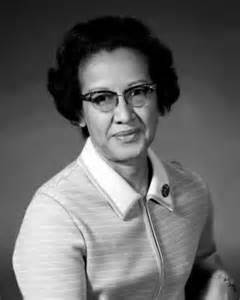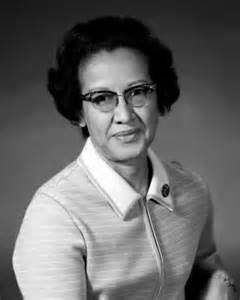
Katherine Coleman Goble Johnson (born August 26, 1918) is an African-American physicist, space scientist, and mathematician. She made fundamental contributions to the United States’ aeronautics and space programs with the early application of digital electronic computers at NASA. Known for accuracy in computerized celestial navigation, her technical leadership work at NASA spanned decades where she calculated the trajectories, launch windows and emergency back-up return paths for many flights from Project Mercury including the early NASA missions of John Glenn, Alan Shepard, the 1969 Apollo 11 flight to the Moon and continued work through the Space Shuttle program and on early plans for the Mission to Mars.
Johnson was born in 1918, to Joshua and Joylette Coleman in White Sulphur Springs, Greenbrier County, West Virginia. She was one of four children. Her father worked as a lumberman, a farmer, a handyman, and at the Greenbrier Hotel. Her mother was a former teacher. Early on, Johnson showed a talent for math. Her parents emphasized the importance of education. Because Greenbrier County did not offer schooling for black students past the eighth grade, the Coleman children attended high school in Institute, Kanawha County, West Virginia. The family split their time between Institute during the school year and White Sulphur Springs in the summer.
Johnson graduated from high school at age 14. At age 15, she began attending West Virginia State College. As a student, Johnson took every math course the college offered. Multiple professors took Johnson under their wings, including chemist and mathematician Angie Turner King, who had also mentored Johnson throughout high school, and W.W. Schiefflin Claytor, the third African American to receive a PhD in math. Claytor added new math courses just for Johnson. She graduated summa cum laude in 1937, with degrees in math and French, at age 18. After graduation, Johnson moved to Marion, Virginia, to teach math, French, and music at a small grade school.
In 1938, Johnson became the first African American woman to desegregate the graduate school at West Virginia University in Morgantown, Monongalia County, West Virginia. She was one of three African American students, and the only female, selected to integrate the graduate school after the United States Supreme Court ruling, Missouri ex rel. Gaines v. Canada.
Johnson decided on a career in mathematics with interest in being a research mathematician, a path with many closed doors for African American women at the time. The first jobs she could find were in teaching. At a family gathering, a relative mentioned that the National Advisory Committee for Aeronautics (NACA), later to become NASA, was looking for new people. They were recently open to hiring African American women for their Guidance and Navigation Department. Johnson was offered a job in 1953, and she immediately accepted and became part of the early NASA team.
According to an oral history archived by the National Visionary Leadership Project:
At first she worked in a pool of technical women performing math calculations, known as computers. Katherine has referred to the women in the pool as virtual “computers who wore skirts.” Their main job was to read the data from the black boxes of planes and carry out other precise mathematical tasks. Then one day, Katherine (and a colleague) were temporarily assigned to help the all-male flight research team. Katherine’s knowledge of analytic geometry helped make quick allies of male bosses and colleagues to the extent that “they forgot to return me to the pool.” While the racial and gender barriers were always there, Katherine says she ignored them. Katherine was assertive, asking to be included in editorial meetings (where no women had gone before.) She simply told people she had done the work and that she belonged.
From 1953 through 1958, Johnson worked as a “computer”, doing analysis for topics such as gust alleviation for aircraft. Originally assigned to the West Area Computers section which was supervised by mathematician Dorothy Vaughan, she was reassigned to the Guidance and Control Division of Langley’s Flight Research Division. However, Ms. Johnson and other African American women in the computing pool were also identified as “colored computers” and subject to workplace segregation, working, eating and using restrooms apart from their white peers until the colored computing pool was disbanded in 1958. From 1958 until she retired in 1986, she worked as an aerospace technologist. She later moved to the Spacecraft Controls Branch. She calculated the trajectory for the space flight of Alan Shepard, the first American in space, in 1959. She also calculated the launch window for his 1961 Mercury mission. She plotted backup navigational charts for astronauts in case of electronic failures. In 1962, when NASA used electronic computers for the first time to calculate John Glenn’s orbit around Earth, officials called on her to verify the computer’s numbers because Glenn asked for her personally and refused to fly unless Katherine verified the calculations. Johnson later worked directly with digital computers. Her ability and reputation for accuracy helped to establish confidence in the new technology. She calculated the trajectory for the 1969 Apollo 11 flight to the Moon. During the moon landing, Johnson was at a meeting in the Pocono Mountains. She and a few others crowded around a small television screen watching the first steps on the moon. In 1970, Johnson worked on Apollo 13’s mission to the Moon. Once the mission was aborted, Johnson’s work on backup procedures and charts helped safely return the crew to Earth four days later. Later in her career, she worked on the Space Shuttle program, the Earth Resources Satellite, and on plans for a mission to Mars.
Johnson co-authored 26 scientific papers. NASA maintains a list of Johnson’s most significant articles with links to its archival search tool to find others.
Johnson’s social impact as a pioneer in space science and computing may be seen both from the honors she has received and the number of times her story is presented as a role model. Since 1979 (before she retired from NASA), Johnson’s biography has had an honored place in lists of African-Americans in science and technology.
On November 16, 2015, President Barack Obama included Johnson on a list of 17 Americans to be awarded the Presidential Medal of Freedom in 2015. She was presented with the award on November 24, 2015, cited as a pioneering example of African American women in STEM.
In March 2016, principal photography began for Hidden Figures, a movie about Johnson and her African-American colleagues at NASA, based on the non-fiction book of the same name by Margot Lee Shetterly, set for release in January 2017. Taraji P. Henson, plays Johnson in the movie.
On May 5, 2016, the new Katherine G. Johnson Computational Research Facility was formally dedicated at the agency’s Langley Research Center in Hampton, Virginia. This occurred on the 55th anniversary of Alan Shepard’s historic rocket launch and splash down, which Johnson helped make possible. Johnson was included in the list of “BBC 100 Women”, a list of 100 inspiring and influential women from around the globe. In a 2016 episode of the NBC series Timeless titled “Space Race”, she is portrayed by Nadine Ellis.
In 1939, she married James Francis Goble and started a family. The Gobles had three daughters: Constance, Joylette, and Katherine. In 1956, James Goble died of an inoperable brain tumor. In 1959, she married Lt. Colonel James A. Johnson and continued her career at NASA. She sang in the choir of Carver Presbyterian Church for fifty years, and is a member of Alpha Kappa Alpha sorority. Johnson and her husband, who have six grandchildren and four great-grandchildren, live in Hampton, Virginia, as of 2016. She continues to encourage her grandchildren and students to pursue careers in science and technology.

